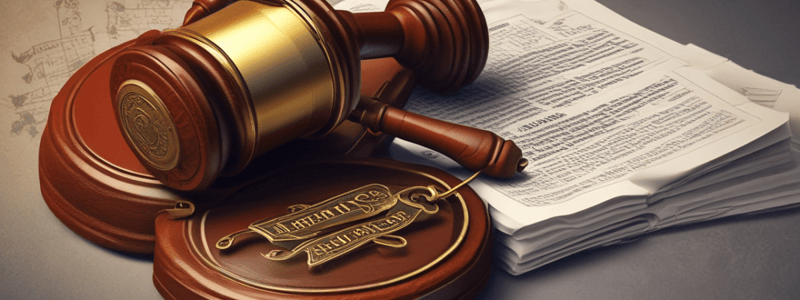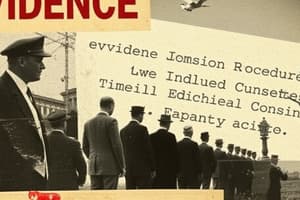Podcast
Questions and Answers
What is the primary concern when handling a firearm as evidence?
What is the primary concern when handling a firearm as evidence?
- Preserving fingerprints, impression evidence, and DNA evidence (correct)
- Conducting a database check on the firearm
- Determining the country of origin of the firearm
- Preventing damage to the barrel rifling
What step should be taken after clearing the chamber or cylinder of a firearm?
What step should be taken after clearing the chamber or cylinder of a firearm?
- Conduct an FCIC/NCIC database check on the firearm
- Remove the magazine and put the ammunition in a separate container
- Examine the weapon to identify the manufacturer, country of origin, and serial number (correct)
- Insert an object into the barrel to check for obstructions
What is the purpose of conducting an FCIC/NCIC database check on a firearm?
What is the purpose of conducting an FCIC/NCIC database check on a firearm?
- To identify the manufacturer of the firearm
- To determine the caliber of the firearm
- To determine if the firearm is lost, stolen, or found (correct)
- To examine the firearm for fingerprints and DNA evidence
What should be done with an object containing an embedded bullet?
What should be done with an object containing an embedded bullet?
What type of devices can store vital evidence and are commonly found at crime scenes?
What type of devices can store vital evidence and are commonly found at crime scenes?
What should be done with the magazine and ammunition after clearing the firearm?
What should be done with the magazine and ammunition after clearing the firearm?
What is NOT a recommended step when examining a firearm as evidence?
What is NOT a recommended step when examining a firearm as evidence?
What is the purpose of examining bullets recovered from a crime scene?
What is the purpose of examining bullets recovered from a crime scene?
What is the primary purpose of an investigation?
What is the primary purpose of an investigation?
What is the good-faith exception doctrine?
What is the good-faith exception doctrine?
What is the main goal of securing and protecting a crime scene?
What is the main goal of securing and protecting a crime scene?
What is an example of a privileged communication?
What is an example of a privileged communication?
What is the focus of the preliminary investigation?
What is the focus of the preliminary investigation?
Why is it important to ensure that crime scene evidence is admissible?
Why is it important to ensure that crime scene evidence is admissible?
What is the role of privileged communications in a crime scene investigation?
What is the role of privileged communications in a crime scene investigation?
What should you do before arriving at a crime scene?
What should you do before arriving at a crime scene?
What precaution should be taken when collecting sharp objects, such as needles or syringes, as evidence?
What precaution should be taken when collecting sharp objects, such as needles or syringes, as evidence?
What is the primary concern when handling fentanyl or carfentanil?
What is the primary concern when handling fentanyl or carfentanil?
When field-testing a suspected fentanyl or carfentanil substance, what should you do?
When field-testing a suspected fentanyl or carfentanil substance, what should you do?
What should you do if you encounter a large amount of powder suspected to be fentanyl or carfentanil?
What should you do if you encounter a large amount of powder suspected to be fentanyl or carfentanil?
What is the purpose of having another officer nearby when handling fentanyl or carfentanil?
What is the purpose of having another officer nearby when handling fentanyl or carfentanil?
What should you do if you are exposed to fentanyl or carfentanil?
What should you do if you are exposed to fentanyl or carfentanil?
What is a sign of exposure to fentanyl or carfentanil?
What is a sign of exposure to fentanyl or carfentanil?
When packaging a substance suspected to be fentanyl or carfentanil, what should you do?
When packaging a substance suspected to be fentanyl or carfentanil, what should you do?
What type of equipment can be used for media storage?
What type of equipment can be used for media storage?
Why should you not manipulate or operate any part of the media storage equipment?
Why should you not manipulate or operate any part of the media storage equipment?
What specialized training is required for computer evidence recovery?
What specialized training is required for computer evidence recovery?
What should you consider doing when seizing a mobile electronic device?
What should you consider doing when seizing a mobile electronic device?
Under what circumstances can you search a cell phone without a search warrant?
Under what circumstances can you search a cell phone without a search warrant?
What is the purpose of the chemistry section in a crime laboratory?
What is the purpose of the chemistry section in a crime laboratory?
What is the purpose of submitting an FDLE public records request to the toxicology section of a crime laboratory?
What is the purpose of submitting an FDLE public records request to the toxicology section of a crime laboratory?
Why is it essential to stay current with agency policies and procedures regarding electronic evidence?
Why is it essential to stay current with agency policies and procedures regarding electronic evidence?
What should you do before a pretrial meeting?
What should you do before a pretrial meeting?
What should you be prepared to discuss with the prosecutor during the pretrial meeting?
What should you be prepared to discuss with the prosecutor during the pretrial meeting?
Why is it important to identify potential weaknesses in the case?
Why is it important to identify potential weaknesses in the case?
What should you do if you find evidence that does not support the facts presented in the probable cause affidavit?
What should you do if you find evidence that does not support the facts presented in the probable cause affidavit?
What is your continuing obligation to the prosecutor?
What is your continuing obligation to the prosecutor?
What should you be familiar with before the pretrial meeting?
What should you be familiar with before the pretrial meeting?
Why should you discuss the case with agency personnel before the pretrial meeting?
Why should you discuss the case with agency personnel before the pretrial meeting?
What should you do if you find conflicting statements or problems in the documentation of evidence?
What should you do if you find conflicting statements or problems in the documentation of evidence?
What technique can help you when a defense attorney fires questions at you rapidly?
What technique can help you when a defense attorney fires questions at you rapidly?
Why might a defense attorney try to build rapport with you?
Why might a defense attorney try to build rapport with you?
What should you do if a defense attorney mispronounces your name or forgets your title?
What should you do if a defense attorney mispronounces your name or forgets your title?
What is the purpose of a defense attorney's questions?
What is the purpose of a defense attorney's questions?
Why should you stay alert and control your ego during questioning?
Why should you stay alert and control your ego during questioning?
What should you do if a defense attorney leads you to say that you are an expert when you're not?
What should you do if a defense attorney leads you to say that you are an expert when you're not?
Why might a defense attorney try to make you feel insignificant?
Why might a defense attorney try to make you feel insignificant?
What should you do when a defense attorney tries to confuse you with rapid-fire questions?
What should you do when a defense attorney tries to confuse you with rapid-fire questions?
Why is it essential to stay calm and composed during questioning?
Why is it essential to stay calm and composed during questioning?
What should you do if a defense attorney tries to lead you into saying something that is not true?
What should you do if a defense attorney tries to lead you into saying something that is not true?
Flashcards are hidden until you start studying
Study Notes
Good Faith Exception Doctrine
- If a search warrant is executed in good faith but later found to have a legal error, the seized evidence may still be admissible in court.
Privileged Communication
- Certain relationships have privileged communication, such as between a sexual assault counselor and a sexual assault victim, or a domestic violence advocate and a domestic violence victim.
- These interactions are private, protected, and confidential, and their disclosure cannot be forced.
Crime Scene Follow-Up Investigations
- Purpose of an investigation: determine what happened during an incident, identify and locate the suspect, and develop enough evidence to establish probable cause to make an arrest.
- Preliminary investigation focuses on establishing whether a criminal act has been committed and, if so, what type and when and where it was committed.
Firearm Evidence
- When collecting a firearm as evidence, always properly secure the weapon, remove the magazine, clear all ammunition from the chamber or cylinder, and carefully examine the weapon to identify the manufacturer, country of origin, serial number, model number, and caliber.
- Document this information in field notes for database checks and final reports.
FCIC/NCIC Database Check
- Use the serial number to conduct an FCIC/NCIC database check on the firearm to determine if it is lost, stolen, or found.
Electronic Evidence
- Types of electronic devices that can store vital evidence include cell phones, tablets, laptops, desktops, thumb drives, external drives, removable disks, tapes, and digital cameras.
- Do not manipulate or attempt to operate any part of the equipment to avoid possible damage.
- Consider placing a mobile electronic device in “airplane mode” or an antistatic Faraday bag to prevent remote access or communication.
Chemical or Toxicological Evidence
- The crime laboratory's chemistry section analyzes substances to determine the presence or absence of controlled substances listed under chapter 893, F.S.
- Analysts prepare reports of their findings and often testify in court on the results of their analyses.
- In certain criminal investigations, you may submit an FDLE public records request and obtain an analysis from the toxicology section of a crime laboratory.
Fentanyl and Carfentanil
- Fentanyl and carfentanil are particularly hazardous substances that can be absorbed through mucous membranes.
- When encountering these substances, follow agency policies and procedures for field-testing, collecting, packaging, and transporting.
- Use PPE such as gloves, long sleeves, a surgical or dust mask, and eye protection.
- Conduct field-testing in an open environment with no wind and have another officer nearby with naloxone, the antidote for opioid overdose.
Preparing for a Pretrial Meeting
- Thoroughly review all available case documentation before a pretrial meeting.
- Discuss the case with appropriate agency personnel, such as supervisors, watch commanders, or crime scene and evidence personnel.
- Be prepared to discuss who, what, when, where, how, and why facts of the case, all evidence, and any other relevant information.
- Remain truthful, honest, and accurate when discussing the case with the prosecutor.
Documenting Crime Scene Evidence
- When documenting photographs or sketches of a crime scene and evidence on a person, use a systematic approach or pattern to search for evidence.
- The type of crime scene determines the type of evidence to search for, and the search pattern should be adapted accordingly.
- Use appropriate standard precautions and personal protective equipment (PPE) when searching and handling evidence to avoid exposure to harmful substances.
Searching for Evidence
- Use a grid or spiral search pattern to search for evidence, depending on the type of crime scene and the type of evidence being collected.
- Change gloves between collecting each piece of evidence that requires DNA analysis to prevent cross-contamination.
- Use appropriate tools, equipment, containers, and packaging to prevent contamination and degradation of evidence.
Packaging Evidence
- Use breathable containers, such as paper bags, for wet evidence, such as items soaked with body fluids or living plant material.
- Place each piece of evidence collected for DNA analysis in its own separate container.
- Refer to agency policies and procedures for specific evidence-handling procedures.
Trace Evidence
- Trace evidence is small quantities of material transferred from a victim or suspect to each other or to a crime scene.
- Examples of trace evidence include human hair, animal hair, textile fibers, rope, feathers, soil, glass, and building materials.
- Microanalysis is used to analyze trace evidence and determine its possible source or origin.
Preparing for a Pretrial Meeting
- Thoroughly review all available case documentation before a pretrial meeting.
- Discuss the case with appropriate agency personnel, such as supervisors, watch commanders, and crime scene and evidence personnel.
- Be prepared to discuss the who, what, when, where, how, and why facts of the case, as well as all evidence and relevant information.
Providing Testimony
- Use plain, professional language when providing testimony, avoiding slang, police jargon, and derogatory statements.
- Be courteous and respectful, using proper titles and addressing the judge and jury appropriately.
- Avoid displaying personal interest in the case and maintain a professional demeanor.
- Provide accurate and complete testimony of the available facts, without trying to steer the case.
- Be prepared to respond to objections and challenging questions from the defense attorney.
Studying That Suits You
Use AI to generate personalized quizzes and flashcards to suit your learning preferences.




